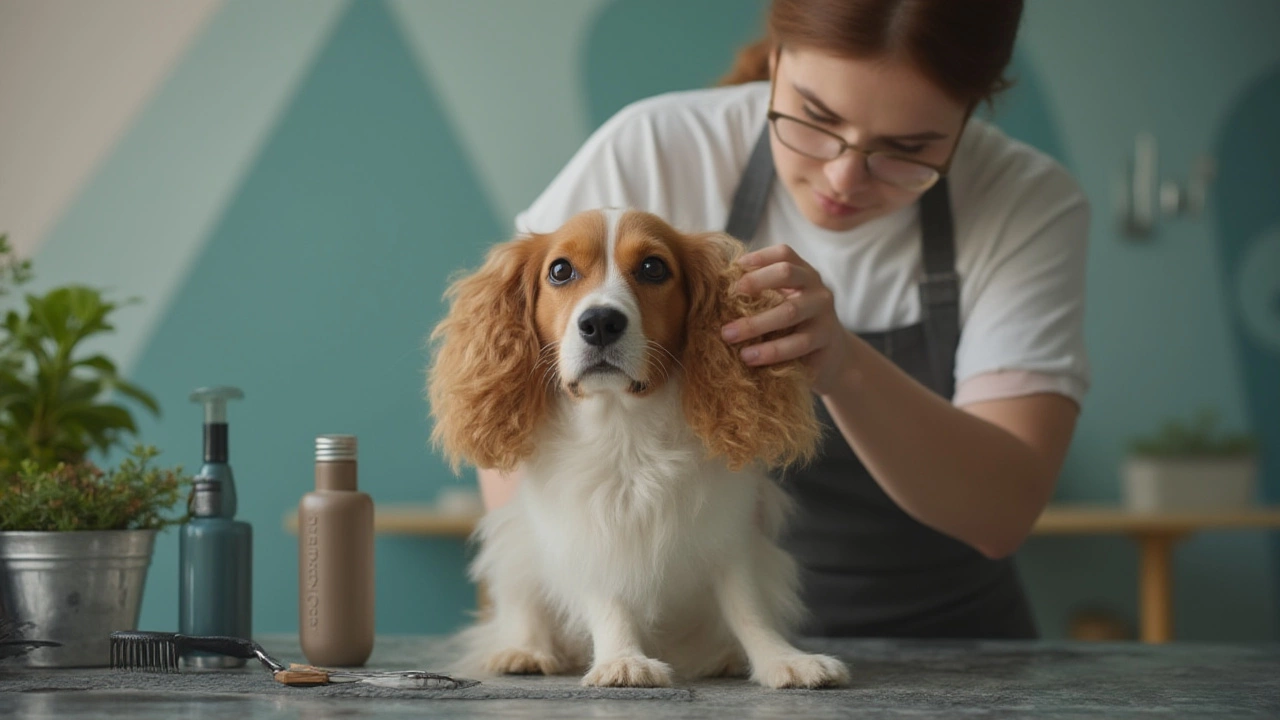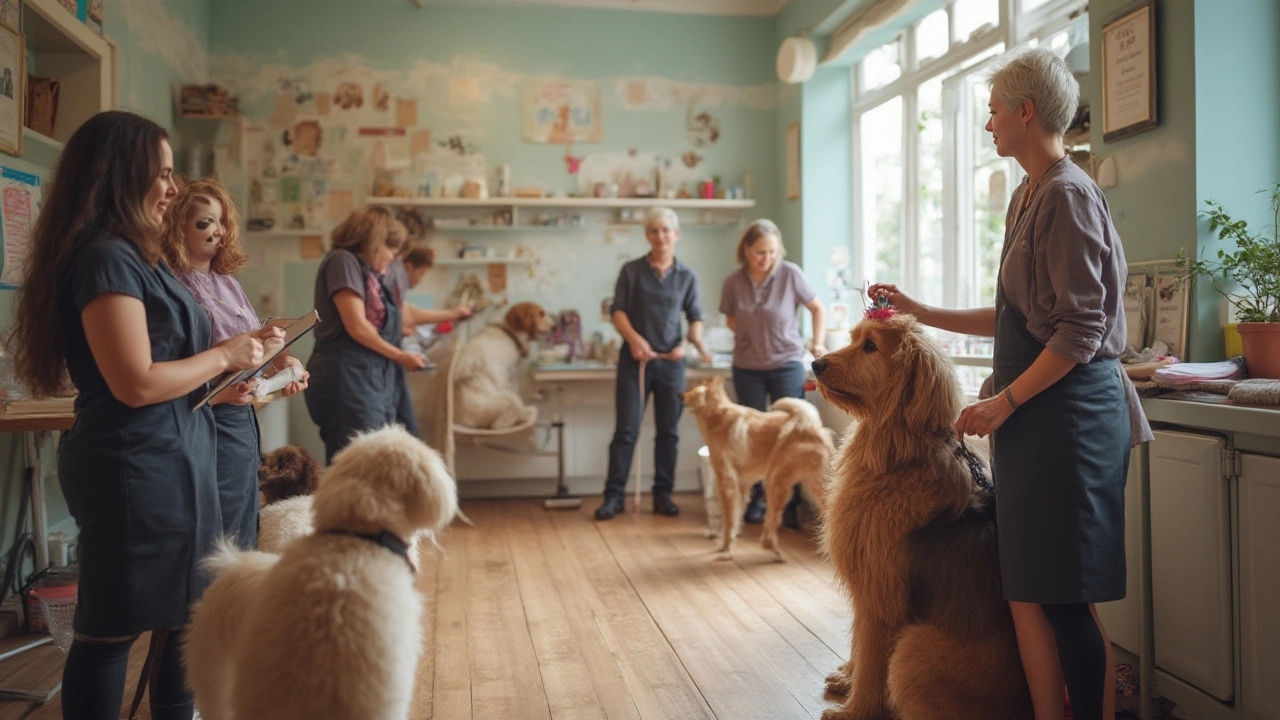The classic grooming drop-off goes like this: you hand over a bouncy, slightly scruffy dog, sign a form, and the smiling groomer says, “Come back in four hours.” Four hours? For a wash and a haircut? You might wonder if your pup is being taught to paint or nap in a private suite for half the day. But there’s a lot that goes on behind those salon doors.
What Really Happens During a Dog Grooming Visit?
Grooming salons are a flurry of activity, with time spent on much more than simply snipping fur. Dogs come in all shapes, sizes, and temperaments, and each adds a unique wrinkle to the day. First, a groomer does a check-in, examining each dog’s coat, skin, and general health. This isn’t just ticking a box: issues like mats, fleas, sore spots, or even lumps have to be found before the bath begins. Around 70% of groomers report uncovering health concerns pets owners hadn’t noticed, and in some cases, a quick trim catches early signs of skin infection or joint issues.
Once the basics are sorted, the bath stage starts, and it’s not a speedy splash. Quality shampoos, conditioners, and sometimes medicated rinses do their work while the dog gets gently massaged and reassured. Large breeds or thick, curly coats take way more time. Some poodles require up to three thorough rinses to get suds out—imagine washing a deep-pile carpet that keeps wiggling. Dogs who dislike water or have anxiety will need extra patience, slowing the process. Some breeds—like Huskies—have undercoats that must be carefully blown out, sometimes taking 40 minutes just to dry fully.
The drying step might look like pointing a hair dryer and waiting, but high-velocity dryers, towel drying, and hand-finishing take up chunks of the clock. Certain breeds can’t take powerful dryers close to their skin, so groomers carefully work section by section. Each paw, tail, and ear is inspected as they dry, checking for tangles and any hidden debris.
Now, the haircut and styling start, and this is incredibly detailed. Groomers use different blades, scissors, and tools for paws, faces, bellies, and tails. Each area needs careful attention; accidents happen if you rush—a slip with the clippers can nick the skin. For dogs with mats or sensitive areas, cutting takes even longer because working slowly avoids causing pain. Groomers often shape coats based on breed standards—the perfect “teddy bear” trim on a cockapoo takes layers, not just a quick buzz. Even a simple-looking short trim for a Labrador might involve precision scissoring to avoid unevenness.
And then? Nails are clipped (often the bit dogs hate most), ears are cleaned, and sometimes glands are expressed (if you know, you know). Each step adds minutes. Add in cleaning up fur, sanitizing equipment, switching out towels, and dealing with the reality of other dogs barking, jumping, or having bathroom accidents. The clock keeps ticking, and suddenly, that four-hour timescale doesn’t feel so wild.
Why Can't Groomers Go Faster?
Even with experience, groomers aren’t pushing conveyor-belt speeds. Let’s face it—dogs are not static models. They jump, yawn, twist, and flop over. Patience is essential, especially with anxious or first-time dogs. If your pooch decides today’s the day to snap at scissors or wriggle on the table, a safe, gentle approach stretches the timeline. Groomers report that about one in four appointments takes longer than scheduled due to behavioral issues alone.
Then there’s the issue of drying. Dogs can’t be left in crates with a hot dryer blasting them, as that can cause stress or even injuries. Many UK and Irish grooming associations warn against quick-drying techniques—like cage dryers—after accidents in years past. That means much of the process still relies on hand-drying, where each section has to be checked by touch. For double-coated breeds, a too-fast dry can trap moisture next to the skin, leaving room for bacteria and “hot spots.” Safety always wins out over speed.
Tools matter, too. Groomers sharpen and sanitize scissors and clippers between every session. Overheated clipper blades must be swapped out to avoid burns. That means regular breaks to check equipment. There’s also paperwork—keeping client records, noting new allergies or behavior changes, double-checking requests (“No pom-poms on the tail, please!”). Some salons fit in urgent walk-ins or nervous dogs who can’t wait in a crate, throwing off the daily rhythm.
Groomers work alongside other staff, sharing dryers and bath stations. If you’ve ever wondered why your dog comes home with a little bow or fancy bandana, know someone spent actual time threading and knotting. And let’s not forget, a steady flow of barks and meows fills the salon—each extra body in the room distracts both canines and humans, slowing things down. Sometimes, the job is like juggling soapy, wriggly potatoes for half the day.

Factors That Stretch Out Your Dog’s Salon Stay
Multiple things combine to make a dog grooming session a half-day adventure. Some are obvious, while others fly under the radar. Certain breeds, like Old English Sheepdogs, Bichon Frises, or Pomeranians, are simply high-maintenance—groomers need to work layer by layer through dense or curly fur. If your dog’s been skipping regular brushing between appointments (we get it, life’s busy), mats and tangles can eat up half an hour alone.
Below is a handy table that breaks down average time spent on each grooming step for a medium-sized, long-haired dog in a salon setting:
| Grooming Step | Average Time (Minutes) |
|---|---|
| Check-In/Assessment | 10 |
| Initial Brushing/Dematting | 20 |
| Bathing/Shampooing/Conditioning | 20 |
| Drying (Towel + Blower) | 35 |
| De-Shedding/Combing | 15 |
| Haircut/Styling | 45 |
| Nails, Ears, Anal Glands | 15 |
| Breaks, Calming/Behavioral | 20 |
| Cleaning/Sanitation Between Dogs | 15 |
| Final Check & Bow | 10 |
If you’re counting, that adds up to three hours, but throw in delays, more challenging cases, and cleaning between each dog, and you’ve landed at four hours, easy. Sedated dogs, puppies, or elderly pets might move even more slowly. Groomers also have to manage their bookings to avoid a stressful, noisy crush of dogs, so sometimes dogs aren’t groomed straight through but in stages.
Want to help your dog’s groom go smoothly? Brush them regularly at home, especially if you have a breed prone to tangles. Try to keep them calm before arriving, and be upfront with your groomer about any allergies or sensitivities. If your dog is anxious, bring along a favorite toy or blanket from home—the scent can soothe nerves. And schedule appointments on less busy days (often midweek) if your groomer offers staggered drop-offs, as a quieter salon means a less anxious dog and sometimes a faster finish.
How to Make the Grooming Experience Better for Everyone
There’s no magic shortcut to a full dog grooming—it’s about care, safety, and getting it right rather than getting it done. Salon jobs are surprisingly physical. An experienced groomer lifts, dries, trims, and coaxes dozens of dogs a week. The average groomer in Dublin works with 6-8 dogs a day, often staying late to make sure nobody leaves unfinished. Good groomers remember clients by name and know each dog’s quirks—and they want your pet looking their best.
For pet parents who don’t want to wait, express grooming is sometimes offered, trimming time to around two hours for small, well-behaved dogs. That said, “express” comes at a premium price and isn’t suitable for anxious or high-maintenance breeds. Most salons warn that rushing increases the risk of missed mats or stress-related mishaps.
If you’re keen to support your groomer (and make those four hours as productive as possible), here are practical tips:
- Keep up with at-home brushing, especially for curly or long-haired breeds.
- Accustom your pup to being handled—touch their paws and ears at home.
- Stick to a regular grooming schedule to avoid severe matting.
- Provide clear grooming instructions and photos if you’re fussy about the style.
- Pick up promptly at the agreed time to avoid crowding the salon.
For dogs who panic in crowded, noisy salons, look for mobile groomers or ask about “quiet hour” appointments. Some salons now offer smaller crates, calming aromatherapy, or soothing background music. One Irish salon found that classical music reduced dog agitation by 37%. If your budget allows and your pet needs it, private sessions also help sensitive or reactive pets feel safer.
Finally, remember that dog grooming time is as much about safety and health as style. Sometimes, that means your fluffed-up, sweet-smelling pal comes home after an epic salon session, a few hours older—and a lot cuter. Four hours might sound long, but every minute counts for your dog’s comfort, wellbeing, and that oh-so-satisfying bounce in their step when they spot you at pickup.

